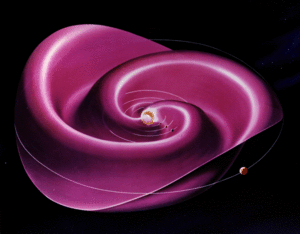Interplanetary medium

The interplanetary medium is the material which fills the Solar System, and through which all the larger Solar System bodies, such as planets, dwarf planets, asteroids, and comets, move.
Composition and physical characteristics
The interplanetary medium includes interplanetary dust, cosmic rays and hot plasma from the solar wind. The temperature of the interplanetary medium varies. For dust particles within the asteroid belt, typical temperatures range from 200 K (−73 °C) at 2.2 AU down to 165 K (−108 °C) at 3.2 AU[1] The density of the interplanetary medium is very low, about 5 particles per cubic centimeter in the vicinity of the Earth; it decreases with increasing distance from the Sun, in inverse proportion to the square of the distance. It is variable, and may be affected by magnetic fields and events such as coronal mass ejections. It may rise to as high as 100 particles/cm³.
Since the interplanetary medium is a plasma, it has the characteristics of a plasma, rather than a simple gas; for example, it carries with it the Sun's magnetic field, is highly electrically conductive (resulting in the heliospheric current sheet), forms plasma double layers where it comes into contact with a planetary magnetosphere or at the heliopause, and exhibits filamentation (such as in aurorae).
The plasma in the interplanetary medium is also responsible for the strength of the Sun's magnetic field at the orbit of the Earth being over 100 times greater than originally anticipated. If space were a vacuum, then the Sun's 10−4 tesla magnetic dipole field would reduce with the cube of the distance to about 10−11 tesla. But satellite observations show that it is about 100 times greater at around 10−9 tesla. Magnetohydrodynamic (MHD) theory predicts that the motion of a conducting fluid (e.g., the interplanetary medium) in a magnetic field, induces electric currents which in turn generate magnetic fields, and in this respect it behaves like an MHD dynamo.
Extent of the interplanetary medium
The outer edge of the Solar System is the boundary between the flow of the solar wind and the interstellar medium. This boundary is known as the heliopause and is believed to be a fairly sharp transition of the order of 110 to 160 astronomical units from the Sun. The interplanetary medium thus fills the roughly spherical volume contained within the heliopause.
Interaction with planets
How the interplanetary medium interacts with planets depends on whether they have magnetic fields or not. Bodies such as the Moon have no magnetic field and the solar wind can impact directly on their surface. Over billions of years, the lunar regolith has acted as a collector for solar wind particles, and so studies of rocks from the Moon's surface can be valuable in studies of the solar wind.
High energy particles from the solar wind impacting on the Moon's surface also cause it to emit faintly at X-ray wavelengths.
Planets with their own magnetic field, such as the Earth and Jupiter, are surrounded by a magnetosphere within which their magnetic field is dominant over the Sun's. This disrupts the flow of the solar wind, which is channelled around the magnetosphere. Material from the solar wind can 'leak' into the magnetosphere, causing aurorae and also populating the Van Allen Belts with ionised material.
Observable phenomena of the interplanetary medium
The interplanetary medium is responsible for several effects which can be seen from Earth. The Zodiacal light is a broad band of faint light sometimes seen after sunset and before sunrise, stretched along the ecliptic and brightest near the horizon. It is caused by sunlight scattering off dust particles in the interplanetary medium between the Earth and the Sun.
A similar effect is the Gegenschein, which is seen directly opposite to the Sun's position in the sky. It is much fainter than the Zodiacal light, and is caused by sunlight reflecting off dust particles outside the Earth's orbit.
History
The term "interplanetary" appears to have been first used in print in 1691 by the scientist Robert Boyle: "The air is different from the æther (or vacuum) in the... interplanetary spaces" Boyle Hist. Air.
The notion that space is considered to be a vacuum filled with an "aether", or just a cold, dark vacuum continued up until the 1950s (see below).
In 1898, American astronomer Charles Augustus Young wrote: "Inter-planetary space is a vacuum, far more perfect than anything we can produce by artificial means..." (The Elements of Astronomy, Charles Augustus Young, 1898).
And Akasofu recounted that: "The view that interplanetary space is a vacuum into which the Sun intermittently emitted corpuscular streams was changed radically by Ludwig Biermann (1951, 1953) who proposed on the basis of comet tails, that the Sun continuously blows its atmosphere out in all directions at supersonic speed" (Syun-Ichi Akasofu, Exploring the Secrets of the Aurora, 2002)
Tufts University Professor of astronomy, Kenneth R. Lang, writing in 2000 noted, "Half a century ago, most people visualized our planet as a solitary sphere traveling in a cold, dark vacuum of space around the Sun".[2]
See also
- Interplanetary space
- Interplanetary dust
- Interplanetary dust cloud
- Interplanetary magnetic field
- Interstellar space
- Interstellar medium
- interstellar dust
- Intergalactic space
- Intergalactic medium
- Intergalactic dust
- List of plasma (physics) articles
References
- ↑ Low, F. J.; et al. (1984). "Infrared cirrus – New components of the extended infrared emission". Astrophysical Journal Letters. 278: L19–L22. Bibcode:1984ApJ...278L..19L. doi:10.1086/184213.
- ↑ Kenneth R. Lang, The Sun from Space (2000) Springer, ISBN 3-540-66944-2. "2. Discovering Space" (page 17)
